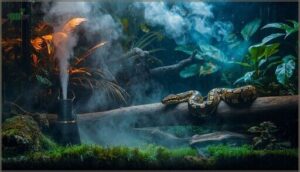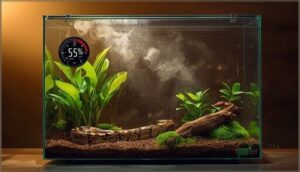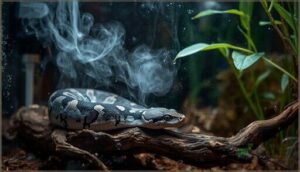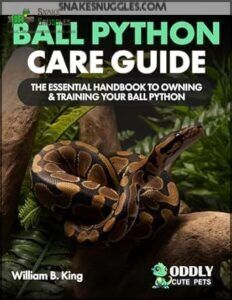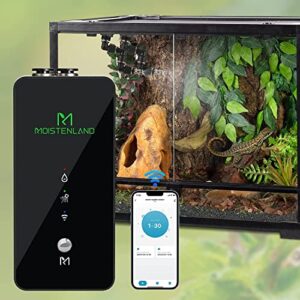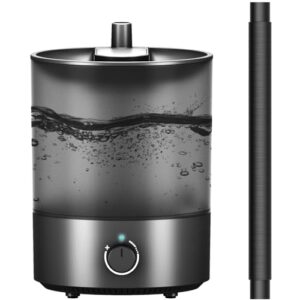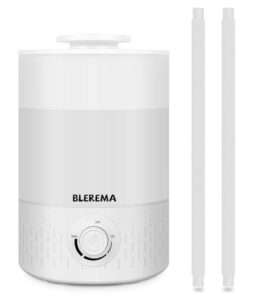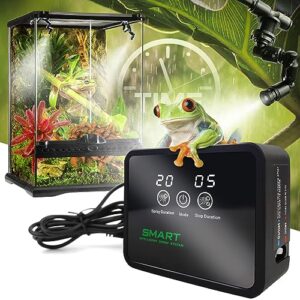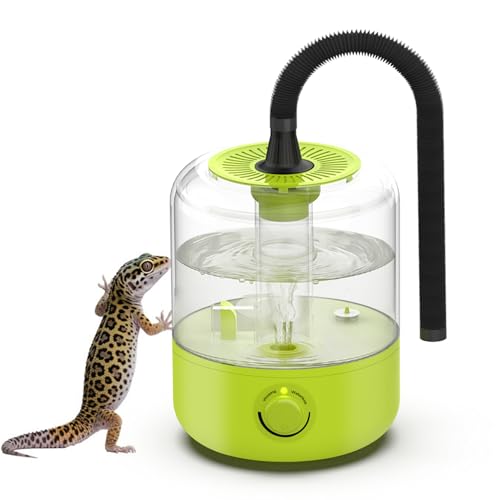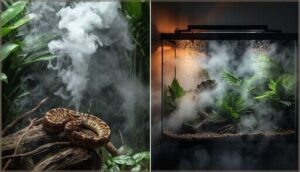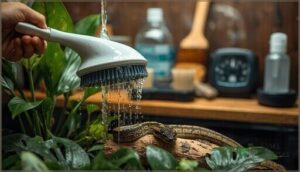This site is supported by our readers. We may earn a commission, at no cost to you, if you purchase through links.
Ball pythons don’t tolerate guesswork regarding humidity. Drop below 50% and you’ll see stuck sheds, dehydration, and respiratory distress within weeks. Push above 70% without proper ventilation and bacterial infections take hold.
A reliable fogger or mister removes the constant manual spraying and humidity anxiety that plagues most keepers. These systems deliver precise moisture control through programmable cycles and adjustable output, maintaining that critical 50-60% range without flooding substrates or creating stagnant air pockets.
The right unit transforms enclosure management from daily intervention to automated precision, letting you focus on observation rather than correction.
Table Of Contents
- Key Takeaways
- Benefits of Foggers and Misters for Ball Pythons
- Proper Humidity Levels for Ball Python Enclosures
- Top 6 Fogger and Mister Products for Ball Pythons
- Choosing The Right Fogger for Your Setup
- Maintenance and Safety Tips for Foggers
- Frequently Asked Questions (FAQs)
- Are misters good for ball pythons?
- Should you mist a Ball Python tank?
- Are foggers bad for boas?
- What is the best cleaner for Ball Python enclosures?
- Can you put a fogger in a ball python tank?
- Are foggers okay for snakes?
- What is the best cleaner for ball python enclosures?
- How often should I refill the foggers water reservoir?
- Can I use essential oils in my ball pythons fogger?
- Do foggers affect the temperature inside the enclosure?
- Conclusion
Key Takeaways
- Ball pythons require 50-60% humidity consistently, with increases to 60-70% during shedding—manual misting creates unreliable conditions that lead to stuck sheds, dehydration, and respiratory infections within weeks.
- Automated foggers and misters eliminate daily humidity adjustments through programmable cycles and adjustable output, maintaining precise moisture control without flooding substrates or creating stagnant air pockets that breed bacteria.
- Weekly cleaning with reptile-safe disinfectants and distilled water prevents dangerous bacterial buildup in misting systems, while GFCI-protected circuits and proper ventilation prevent electrical hazards and over-humidification above 70% that causes scale rot.
- Match fogger capacity to enclosure size (20-40 gallons for juveniles, 40-120 gallons for adults), prioritize ultrasonic models under 35 decibels with leak-proof designs, and verify humidity with calibrated hygrometers at snake head height for reliable monitoring.
Benefits of Foggers and Misters for Ball Pythons
Foggers and misters aren’t just convenience tools—they’re essential equipment for maintaining your ball python’s health and comfort. When humidity levels stay consistent, your snake can shed properly, stay hydrated, and avoid respiratory stress that plagues poorly managed enclosures.
Foggers and misters are essential equipment that keep your ball python healthy by maintaining the consistent humidity needed for proper shedding and respiratory function
Let’s look at the three core benefits that make these devices worth your investment.
Maintaining Ideal Humidity for Health
Humidity control isn’t optional—it’s foundational to your ball python’s long-term health. A reptile fogger with adjustable settings delivers consistent mist output that aids respiratory care and prevents the cascade of problems linked to dry air. When you maintain 50–60% ambient humidity, you’re actively protecting against:
- Upper respiratory infections that compromise breathing
- Dehydration that reduces appetite and vitality
- Incomplete sheds that lead to skin retention
- Chronic stress that weakens immune response
Proper humidifier use means real health benefits, not guesswork. Effective auditing tools like methodological rigor can help improve the accuracy of health studies.
Supporting Proper Shedding and Hydration
Your ball python’s shedding process depends on precise humidity control and hydration monitoring. A reptile fogger with adjustable mist output raises ambient moisture to 60–70% during the pre-shed window, softening old skin without waterlogging.
This targeted approach aids reptile hydration and skin health while preventing retained eye caps. Proper misting schedules coordinate with your snake’s natural cycle, ensuring complete molts every time.
Understanding language patterns is also essential for effective communication about reptile care.
Reducing Stress Through Consistent Environment
Beyond shedding, your reptile fogger delivers environmental consistency that directly impacts ball python behavior. Stable humidity from automated mist output lowers stress indicators you can observe during routine handling.
Here’s what consistent enclosure stability provides:
- Fewer escape attempts and defensive postures
- Normalized feeding response after maintenance
- Reduced tail-whipping during enclosure checks
- Steady respiration without humidity-triggered agitation
Quiet operation with automatic shutoff maintains this stress reduction around the clock.
Proper Humidity Levels for Ball Python Enclosures
Getting the humidity right isn’t guesswork—it’s a measurable standard that directly impacts your ball python’s respiratory health and ability to shed properly. You need to understand both the baseline range your enclosure should maintain and how to adjust during critical periods like shedding.
Pairing proper humidity with quality hiding spots designed for ball pythons creates a microenvironment where your snake feels secure enough to shed and breathe comfortably.
Let’s break down the specific numbers you should aim for and how to track them accurately.
Recommended Humidity Range (50–60%)
Your ball python thrives when you maintain humidity between 50 and 60 percent. This range promotes ball python health by enabling proper shedding process and reducing environmental stress.
For a deeper dive into habitat setup and long-term care, check out this comprehensive ball python ownership guide.
Use a digital hygrometer to monitor humidity control consistently. Position sensors near cooler areas and close to your reptile fogger or humidifier.
Stable mist output and microclimate management prevent respiratory issues while keeping misting frequency predictable.
Regular system checks also help you maintain proper humidity for snakes without the constant guesswork that leads to health complications.
Adjusting Humidity During Shedding Periods
When your ball python enters the shedding process, gradually increase humidity control to 70–90 percent using your reptile fogger or humidifier. Maintain consistent mist output rather than intermittent misting to protect skin health and environmental balance.
After shedding completes, reduce humidity monitoring back to 50–60 percent. This prevents prolonged moisture that compromises respiratory function and enclosure hygiene.
Monitoring With Hygrometers
Reliable hygrometers give you real-time humidity readings to fine-tune your reptile fogger settings and mist output. Dual-sensor models account for enclosure monitoring microclimates, targeting 50–60 percent for daily care.
Regular accuracy checks through hygrometer calibration prevent drift in humidity sensors. Data-logging units track misting patterns over weeks, so you can adjust your humidifier before problems arise.
Top 6 Fogger and Mister Products for Ball Pythons
You’ll find several reliable foggers and misters designed specifically for reptile enclosures. Each product offers different features to match your setup size, automation needs, and budget.
Here’s what works well for maintaining proper humidity in ball python habitats.
1. Ball Python Care Handbook
You’ll make better decisions when you invest $0.99 in a 52-page resource that covers Ball Python Diet, Snake Habitat, and Reptile Health essentials. This handbook distills practical Pet Care Tips on Animal Behavior, feeding schedules, and illness prevention into step-by-step guidance.
While it doesn’t review Humidifier or Reptile Fogger hardware, it provides the foundational Reptile Care knowledge you need before choosing equipment. Understanding proper humidity targets and Terrarium Maintenance routines ensures your fogger purchase actually aids your Ball Python’s wellness instead of creating new problems.
| Best For | New and experienced ball python owners who want a quick, affordable guide covering diet, habitat setup, health monitoring, and humidity management before investing in enclosure equipment. |
|---|---|
| Type | Care Guide Book |
| Price Range | Budget |
| Suitable For | Ball Pythons |
| Ease of Use | Simple Read |
| Capacity | 52 Pages |
| Special Feature | Breeding Guide |
| Additional Features |
|
- Covers all the essentials—feeding schedules, temperature gradients, humidity targets, and shedding cycles—in a compact 52-page format that won’t overwhelm beginners.
- Includes practical monitoring tips like hygrometer placement and record-keeping routines that help you spot health issues early and maintain consistent conditions.
- At $0.99, it’s an inexpensive way to build foundational knowledge before spending money on foggers, substrates, or other gear you might not actually need.
- Doesn’t review specific humidifier models or fogger brands, so you’ll need to research equipment separately after reading.
- The 52-page length means advanced topics like morphs, breeding genetics, or complex medical treatments get minimal coverage.
- Assumes you already understand basic reptile care concepts, which might leave absolute beginners needing supplemental resources.
2. Reptile Terrarium Misting System Controller
When precision matters more than guesswork, a misting system controller transforms your terrarium environment into a hands-off habitat. Controllers coordinate automated misting cycles through programmable misting schedules, adjusting spray duration based on real-time humidity sensors that provide feedback within ±5% RH accuracy.
You’ll achieve system compatibility with most 40-gallon enclosures and standard nozzles. Remote monitoring through app-enabled models lets you track trends and tweak setpoints without opening the enclosure.
Controller features like over-humidity protection and fail-safe dry-run shutdowns prevent both waterlogging and pump damage, giving you consistent reptile terrarium care with minimal intervention.
| Best For | Reptile owners who want automated humidity control without constantly checking gauges or manually misting their ball python’s enclosure. |
|---|---|
| Type | WiFi Misting System |
| Price Range | Mid-Range |
| Suitable For | Snakes, Lizards, Turtles |
| Ease of Use | App-Controlled |
| Capacity | Not Specified |
| Special Feature | Remote Monitoring |
| Additional Features |
|
- Remote app control lets you adjust misting schedules and monitor humidity levels from anywhere without disturbing your snake
- Built-in safety features like over-humidity protection and dry-run shutoffs prevent enclosure flooding and equipment damage
- Real-time humidity sensors with ±5% accuracy keep conditions stable and eliminate the guesswork of manual misting
- Some users report leakage issues and water flooding, especially if installation isn’t properly sealed
- The pump can be noisy during nighttime misting cycles, which might disturb both you and your reptile
- Scheduling limitations mean intervals start from setup time rather than exact clock times, and timing changes don’t always register in the app
3. Reptile Humidifier Fogger System
A Reptile Humidifier Fogger System combines reservoir capacity with adjustable mist output to meet reptile humidification needs without constant refills. You’ll find fogger system design features like automatic shutoff and leak-proof seals that protect both your snake and your electrical connections.
Humidity control methods rely on misting frequency adjustment—dial in shorter bursts for maintenance or extended cycles during shed periods. Quiet operation keeps stress low, while fogger maintenance tips like weekly descaling and distilled water use prevent mineral buildup.
This reptile fogger delivers consistent humidity when you balance misting schedules with proper ventilation.
| Best For | Reptile keepers who need a hands-off way to maintain steady humidity for ball pythons, chameleons, or other moisture-dependent species without manual spraying every day. |
|---|---|
| Type | Automatic Fogger |
| Price Range | Mid-Range |
| Suitable For | Turtles, Chameleons, Frogs |
| Ease of Use | Easy to Clean |
| Capacity | 2.8L Tank |
| Special Feature | Auto Shutdown |
| Additional Features |
|
- Large 2.8L tank means fewer refills and longer misting sessions between maintenance stops.
- Automatic shutoff kicks in when water runs low, protecting the pump and preventing dry-run damage.
- Quiet operation won’t stress out sensitive reptiles or disrupt your space during nighttime misting cycles.
- Some users report leaks around the seal and lid, which can create puddles and humidity control headaches.
- Durability is hit-or-miss—several reviews mention units breaking down after just a few months of regular use.
- Hose and lid design flaws make setup and cleaning more frustrating than it should be.
4. Reptile Tank Fogger Humidifier System
You’ll need a fogger that integrates cleanly into your existing tank setup without creating dead zones or soaking substrate. System Architecture matters—look for units with separate reservoirs, adjustable tubing, and dual nozzle outputs for even distribution.
Automation Options like timers let you schedule humidity pulses during critical shed cycles. Tank Integration depends on suction mounts or external placement that won’t stress your python.
Quiet Operation below 35 decibels prevents disturbance, while Mist Output controls fine-tune humidity without oversaturation. Clean nozzles weekly to maintain performance.
| Best For | Ball python keepers who want automated humidity control with adjustable misting schedules and minimal daily maintenance. |
|---|---|
| Type | Ultrasonic Fogger |
| Price Range | Mid-Range |
| Suitable For | Bearded Dragons, Geckos, Snakes |
| Ease of Use | Top-Fill Design |
| Capacity | 3L Tank |
| Special Feature | Dual Mist Output |
| Additional Features |
|
- Top-fill design with 3-liter capacity means fewer refills and easy cleaning through the large opening
- Dual mist outputs let you distribute fog evenly across larger enclosures without dead zones
- Timer-compatible system allows scheduled humidity pulses during shed cycles without constant monitoring
- Some units stop working after a few days or require frequent troubleshooting to maintain consistent output
- Stiff, short hoses and weak suction cups often need DIY extensions or alternative mounting solutions
- Mineral buildup clogs nozzles quickly, requiring weekly cleaning even with distilled water
5. Reptile Terrarium Mist System
Automated misting systems deliver precision humidity control through programmable spray cycles that match your ball python’s natural rhythms. The MYGIIKAKA reptile terrarium mist system uses dual adjustable nozzles and customizable intervals—spray durations from 5 to 60 seconds, stop times from 1 to 24 hours—so you can calibrate misting frequency without oversaturating substrate.
Water quality affects nozzle performance, so flush the reservoir weekly and check tubing integrity.
This setup works best for mid-sized enclosures where consistent humidity control between 50 and 60 percent promotes healthy shedding cycles.
| Best For | Ball python owners who want to automate humidity control in mid-sized enclosures without constantly adjusting manual spray bottles or risking substrate oversaturation. |
|---|---|
| Type | Intelligent Misting System |
| Price Range | Mid-Range |
| Suitable For | Ball Pythons, Geckos |
| Ease of Use | 3-Button Setup |
| Capacity | Not Specified |
| Special Feature | Adjustable Spray Cycle |
| Additional Features |
|
- Dual adjustable nozzles let you fine-tune spray coverage and customize intervals from 5 to 60 seconds with stop times up to 24 hours
- Simple three-button setup makes programming misting schedules straightforward, even for first-time reptile keepers
- Maintains steady 50-60% humidity levels that support healthy shedding cycles without manual intervention
- Nozzles may drip or leak between cycles, potentially creating wet spots or damaging enclosure materials
- Unit can be loud and vibrate during operation, which might stress sensitive reptiles or disturb nearby living spaces
- Limited flexibility in spray patterns and reservoir placement makes it less suitable for large or complex terrarium layouts
6. Reptile Terrarium Cool Mist Humidifier
The LURMMUE unit combines ultrasonic technology with a generous 2.5-liter tank capacity, providing up to 24 hours of cool mist without adding heat to your ball python’s environment. You can adjust mist output control through a single-button interface, switching between top misting and dual-hose configurations to match enclosure size.
This reptile fogger works well for 20- to 40-gallon terrariums, delivering consistent humidity. Sensors help you track levels. The auto shut-off feature prevents over-humidification when the reservoir runs dry, protecting both your humidifier and your snake’s respiratory health.
| Best For | Reptile owners seeking consistent humidity for ball pythons, chameleons, and other moisture-dependent species in 20- to 40-gallon enclosures without adding heat. |
|---|---|
| Type | Top-Fill Fogger |
| Price Range | Mid-Range |
| Suitable For | Chameleons, Geckos, Frogs |
| Ease of Use | One-Button Operation |
| Capacity | 2.5L Tank |
| Special Feature | Auto Shut-Off |
| Additional Features |
|
- Large 2.5L tank runs up to 24 hours between refills, reducing daily maintenance
- Adjustable mist settings and dual-hose option let you customize coverage for different enclosure sizes
- Auto shut-off prevents dry burns and over-humidification when water runs out
- Requires regular descaling every 2–4 weeks in hard water areas to prevent clog buildup
- May struggle to cover very large vivariums beyond 40 gallons effectively
- Needs careful placement and monitoring to avoid creating overly saturated spots that encourage mold
Choosing The Right Fogger for Your Setup
Your enclosure’s unique characteristics determine which fogger will work best for your ball python. A unit that performs well in a small glass terrarium won’t necessarily suit a large PVC enclosure with different ventilation patterns.
Let’s break down the two critical factors you need to match with your setup.
Enclosure Size and Compatibility
Your enclosure’s dimensions shape your fogger choice. Juveniles in 20- to 40-gallon setups need less output than adults in 40- to 120-gallon spaces. You’ll want at least 36 inches by 18 inches of floor space for proper humidity control.
Larger terrariums demand higher-capacity misting systems to maintain the 50–60% range. Ventilation systems must balance air exchange with moisture retention—seal gaps around doors to prevent humidity loss.
Match your reptile fogger to your enclosure design for ideal animal comfort and space optimization.
Noise Level and Leak-Proof Design
Silent operation and zero leaks separate reliable foggers from equipment that disrupts your snake’s rest cycle or damages your setup. You’ll want ultrasonic models operating under 35 decibels—quieter than a whisper. MistKing misting systems deliver quiet performance without compromising humidity control.
Check for leak-proof design features like reinforced tubing connections and sealed reservoirs. Ball Python reptile humidifier reviews consistently highlight device durability as critical for long-term use. Leaking units create electrical hazards and bacterial growth that threaten your animal’s health.
Maintenance and Safety Tips for Foggers
Your fogger won’t do its job if you don’t maintain it properly, and poor maintenance can actually harm your snake. Regular cleaning and smart operation keep humidity stable while preventing bacterial blooms and equipment failures.
Here’s what you need to know to keep your system running safely and effectively.
Cleaning Frequency and Techniques
You’ll need to clean your fogger weekly to protect your ball python from harmful bacterial buildup. Disassemble all nozzles, hoses, and reservoirs during each cleaning schedule. Use a reptile-safe disinfectant, rinse thoroughly, then air-dry completely.
Keep maintenance logs documenting each fogger sanitization session. This routine terrarium maintenance guide ensures your misting system delivers safe humidity for proper reptile enclosure management and reptile care and maintenance.
Preventing Bacterial Growth and Water Quality
Water purification forms your first line of defense against dangerous microbial contamination. Always use distilled or dechlorinated water in your misting system—MistKing and similar systems demand this standard for safe reptile hydration and humidity delivery.
- Replace reservoir water daily to prevent stagnation and bacterial control failures
- Sanitize all humidifier components with 1:32 bleach solution weekly, then rinse completely
- Install basic filtration systems to reduce organic matter feeding microbes
- Monitor water clarity as part of your terrarium maintenance guide routine
Avoiding Electrical and Over-Humidity Hazards
Beyond water quality, electrical safety and humidity control are critical areas where mistakes can harm both your equipment and your ball python. You need GFCI-protected circuits for all fogging devices, including MistKing systems, to prevent shock hazards.
| Safety Area | Best Practice | Target/Specification |
|---|---|---|
| Electrical Safety | GFCI-protected circuits with drip-loop routing | Prevents short circuits and shock risk |
| Humidity Control | Calibrate misting to maintain stable levels | 50–60% baseline, 60–70% during shed |
| Device Calibration | Use hygrometer at snake head height | Monitor basking area humidity accurately |
| Hazard Prevention | Install auto-shutoff and leak-proof design | Stops operation when water runs low |
| Fogger Maintenance | Monthly safety checks and component inspection | Verify cable integrity and outlet grounding |
Position your humidifier components above substrate level to minimize moisture exposure. Schedule intermittent fogging with sufficient ventilation between cycles—sustained humidity above 70% encourages respiratory infections and scale rot in ball pythons.
Frequently Asked Questions (FAQs)
Are misters good for ball pythons?
Yes, when used correctly. Misting systems maintain the 50–60% humidity range your ball python needs for healthy skin and complete sheds, but they must supplement—not replace—proper ventilation and substrate moisture balance.
Should you mist a Ball Python tank?
You should mist a ball python tank when humidity drops below 50%, targeting 50–60% normally and 60–70% during shedding. Use controlled misting systems like MistKing to maintain proper humidity without over-saturating substrate.
Are foggers bad for boas?
Foggers pose risks for boas when overused. Continuous fogging without airflow creates respiratory issues and mold.
Targeted misting during shedding cycles maintains boa health better than constant humidity saturation, which affects snake behavior and enclosure safety.
What is the best cleaner for Ball Python enclosures?
Use a 1:10 bleach solution for disinfecting your ball python enclosure, followed by thorough rinsing. Reptile-safe enzyme cleaners and 3% hydrogen peroxide work well for routine maintenance without harsh residues.
Can you put a fogger in a ball python tank?
You can install a fogger in your ball python’s enclosure to support humidity targets of 50–60%. Proper placement, ventilation balance, and hygrometer monitoring prevent over-saturation and respiratory complications from excess moisture.
Are foggers okay for snakes?
You might wonder if your ball python’s respiratory infection stems from equipment choices. Foggers are acceptable for snakes when used as supplementary humidity tools, not primary sources.
Monitor enclosure ventilation and airflow to prevent stagnant microclimates that compromise respiratory health.
What is the best cleaner for ball python enclosures?
Choose a reptile-safe disinfectant like 70% isopropyl alcohol or chlorhexidine solution for your ball python enclosure.
Always rinse thoroughly and let surfaces dry completely before returning your snake to prevent respiratory irritation.
How often should I refill the foggers water reservoir?
Daily reservoir checks prevent humidity dips that stress your snake. Refill every 24 hours for small enclosures, increasing to twice daily during shedding.
Fogger maintenance and water capacity directly impact your misting system’s reliability and humidity targets.
Can I use essential oils in my ball pythons fogger?
Never add essential oils to your ball python’s fogger. Essential Oil Risks include reptile toxicity, respiratory distress, and fogger damage.
Prioritize Fogger Safety with Oil Free Alternatives for proper Humidity Management in terrariums.
Do foggers affect the temperature inside the enclosure?
Unlike old-timey steam radiators, foggers don’t meaningfully alter your enclosure’s temperature. Most operate at room temperature, adding humidity without heat transfer.
Your thermostat and heating elements handle temperature regulation—foggers simply manage moisture dynamics in terrariums.
Conclusion
Your ball python won’t adapt to inconsistent conditions—automation isn’t optional. A quality fogger mister for ball pythons eliminates the guesswork that leads to stuck sheds and respiratory complications.
Choose equipment that matches your enclosure dimensions, commit to weekly cleaning protocols, and verify output with calibrated hygrometers. The difference between adequate husbandry and peak health lies in reliable humidity delivery.
Your snake deserves better than manual spray bottles and reactive interventions.
- https://reptilecentre.com/collections/foggers
- https://www.youtube.com/watch?v=JbDIbnK9bys
- https://academichelpexpress.blog/2024/08/please-use-the-bulleted-points-and-the-rubric-below-to-guide-your-work-your-pa/
- https://www.onelook.com/?loc=olthes1&w=subpoint
- https://www.sciencedirect.com/science/article/pii/S0749208123000268


